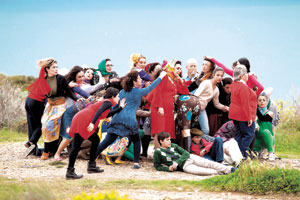
Museum ofContemporary ArtS anta Barbara photos
When talking to artist Marinella Senatore, whose show “Building Communities” is currently up at Museum of Contemporary Art Santa Barbara, aka MCASB, the word “ethics” comes up several times. In her participatory works, she acts as a sort of producer, overseeing the creation of a work — be it an opera, or a film, or a series of photos — with the participation of people from small towns and inner cites around Europe.
“I’m critical and skeptical about many public projects,” she says. “Sometimes I think the role of the artist is abusive. They are using the energy of the people for their own cause. From the beginning they already have a clear idea of what they want to make and won’t change anything.”


Ms. Senatore’s work is about allowing the people to decide what art gets made. She provides the parameters.
The busy and talkative Ms. Senatore is from a working-class family in Italy, and trained as a classical violinist. However, for art training she attended the National Film School in Rome, Italy and studied under famed cinematographer of Fellini and Visconti, Giuseppe Rotunno. She learned to be a camera operator, but more importantly she saw how a group of people can come together and work toward one goal.
The exhibit she brings to MCASB is the result of years of working with people to create art that has more of the participants’ stamp on it than hers. Perhaps her invisibility is indeed her style. Regardless, she has also created three areas in the exhibit space to allow Santa Barbarans a chance to create their own art.
“I feel the role of the artist and the role of the audience in contemporary art is changing very much,” she says. “Participation can be one of the responses to this change. I like to activate processes instead of just representing my ideas.”
Turn immediately left upon entering MCA and one will see a “movie set,” a compact dance studio with mirrored walls, ballet bar, a “skylight,” Fresnel lights, and an HD video camera. In the museum’s main space, “The School of Narrative Dance” offers a dance floor, a video monitor from which to view suggested dances, and a camera to record the resulting work. In a back room, there’s a desk at which to work on writing. All three areas can be booked by visitors to create their own art. The last is a continuation of a work she started in New York’s Lower East Side in 2011.
Her 2012 work, “Rosas” included 20,000 people and three European cities. It’s an opera of sorts and will be screened in the gallery in a prism-shaped screen in the middle of the museum.
Near the screens are two large photographs featuring two crowds from a work she began in Sardinia. The people chose their own characters, their own costumes, and their own poses. Looking at the photos, one would imagine the hand of the artist shaping the composition and the location, but Ms. Senatore says no, the whole thing came from their own needs and creativity. She just set it in motion. Many were illiterate, some were unemployed. It’s not that she seeks any one group out, that’s just how working with small towns works out. But going into their towns, she’s always surprised to find people who are already skilled in the arts who want to help.
“You can find an amateur photographer sometimes,” she says. “You can find a carpenter. Or a builder … You can find ability and skills in people that even their neighbors don’t know. It’s not required to be a professional.”